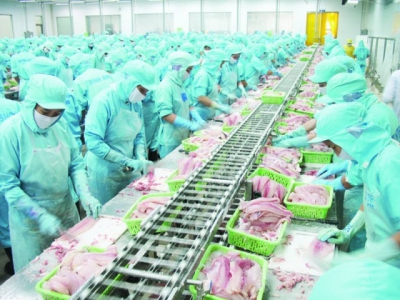Seafood export target hardly reach 10 billion USD

With difficulties facing both objective and subjective expectations, the goal of seafood export to reach 10 billion USD this year is not easy to achieve.
Photo illustration. Photo: Nguyen Thanh
According to the Department of Agricultural Product Processing and Market Development (Ministry of Agriculture and Rural Development), as of the end of August, seafood export value is about 5.52 billion USD, down by 1.2 percent compared to the previous year.
Japan, the United States, China and South Korea were the top four import markets for Vietnam's seafood in the first seven months, took 56.5 percent of the total seafood export value.
At the end of June, at the Preliminary Conference for the first six months of the Ministry of Agriculture and Rural Development, Minister of Agriculture and Rural Development Nguyen Xuan Cuong said that in the second half of the year, in the difficult context, efforts of the whole industry are needed, in which, with a focus on speeding up.
The "commander" of the industry pointed out: "First, we have to accelerate and speed the forestry sector in general, including the forestry economy because there are opportunities. Besides, exploitation and farmer seafood are speeding up. Although seafood prices are not high, there is still area to focus on development.”
Even forestry and fishery products are recognised by Minister Cuong as two "rescue areas" for growth as well as export targets for the whole agricultural sector.
However, to the present time when only a few months are left in 2019, based on the achieved results, the seafood export situation this year is not very satisfactory.
General Director of the General Department of Fisheries (MARD) Tran Dinh Luan said that while the indicators of the growth rate of production value or total fisheries production are basically consistent with the production capacity of the industry, export turnover target was quite high.
Specifically, in 2019, the fisheries sector was assigned by the minister basic criteria such as growth rate of production value to reach 4.69 percent; total fishery production reached 8.08 million tonnes (up 4.2 percent) and export turnover reached USD 10 billion (up 19.3 percent).
Dinh Luan said the seafood export target is 10 billion USD, up by 13.7 percent compared to the implementation in 2018 of 8.794 billion USD. Meanwhile, the average export growth rate in the past 5 years is 5.5 percent per year.
In addition, in 2019 there are many unpredictable factors affecting Vietnam's seafood exports.
First of all, trade conflicts have no end signs, which will have a significant impact on trade policies, the import-export balance. In addition, technical barriers of export markets are increasing with stricter regulations and trade competition is increasingly fierce,
Luan is also quite disturbed with very complicated weather events, affecting the aquaculture, not to mention big storms and tropical depressions.
“Another difficulty of the fishery industry is that the aquaculture is still fragmented, small, has not implemented the value chain link, especially in the exploitation is not much. Meanwhile, infrastructure (fishing ports, anchoring areas to shelter from storms, etc.), preservation of post-harvest products and processing of exploited fishery products are inadequate and do not meet requirements,” Luan said.
One of the factors mentioned by the Directorate of the General Department of Fisheries is the application of science and technology, technological advances in fishing are limited, post-harvest losses are high, the quality of raw materials decreased capture fisheries due to storage led to low production efficiency.
"To achieve the planned targets, the fisheries industry will have to make a lot of effort," Luan emphasised.
The import value of fishery products in the first eight months reached USD 1.19 billion, up 3.8 percent over the same period in 2018. The largest seafood import market in the first 7 months was Norway, took 12, 2 percent market share, followed by India and China with 11.7 percent and 7.7 percent, respectively. In the first seven months of the year, the market with the strongest value of seafood imports increased over the same period in 2018, the Philippines (3.1 times). In contrast, the market with the strongest decrease in seafood import value is India (down 46.8 percent) compared to the same period in 2018.
Related news
 New Minh Phu plants to boost shrimp exports to EU, Australia & China
New Minh Phu plants to boost shrimp exports to EU, Australia & China New plants of country's biggest shrimp exporter to focus on exports to EU, Australia and China.
 Why fish farmers must hurry slowly in their quest for technological progress
Why fish farmers must hurry slowly in their quest for technological progress The need to ensure that new technological systems are actually safe to trial on salmon was the central strand of a talk
 Aquatic yellow cards greatly affect the export of businesses
Aquatic yellow cards greatly affect the export of businesses On September 25, at the two-year review conference implementing the program of Seafood Enterprises committed to combating illegal